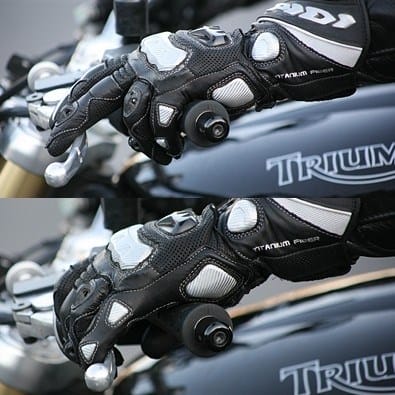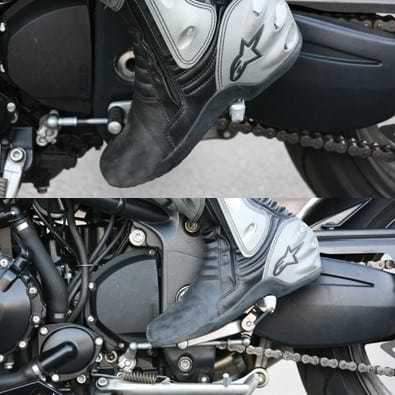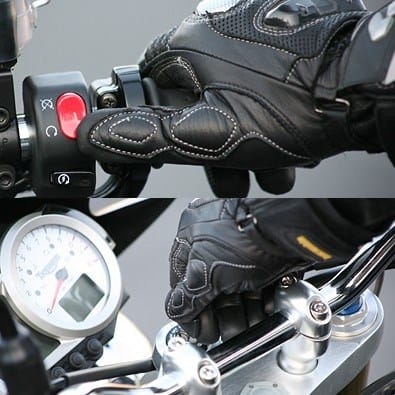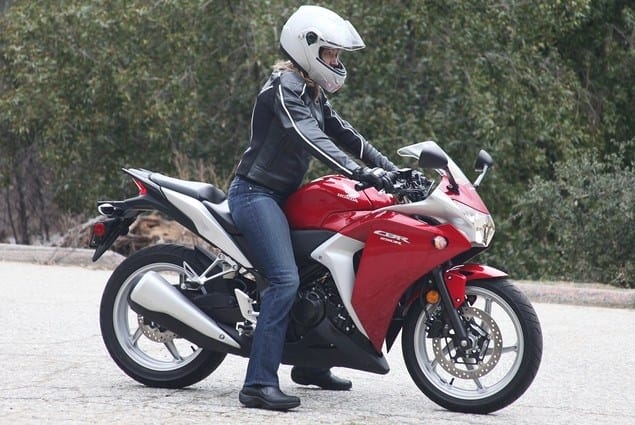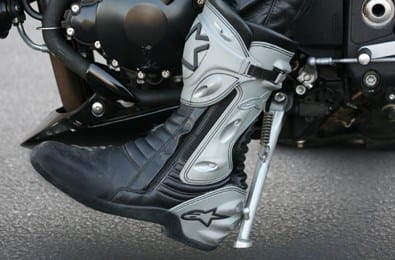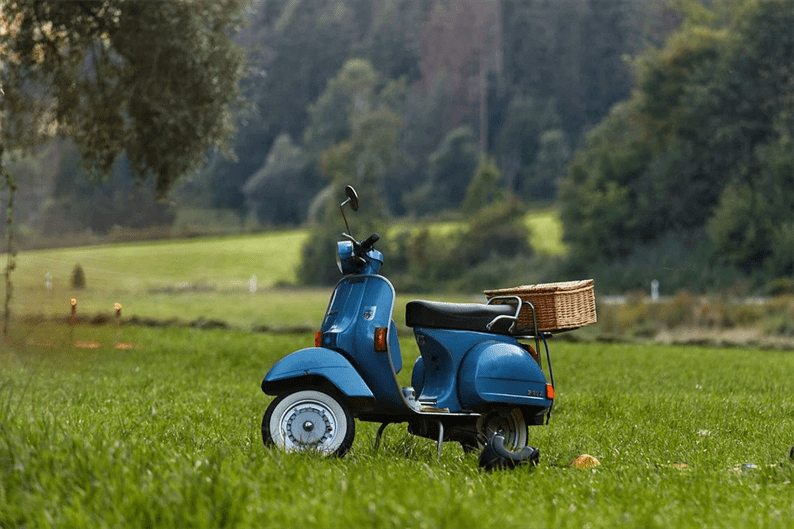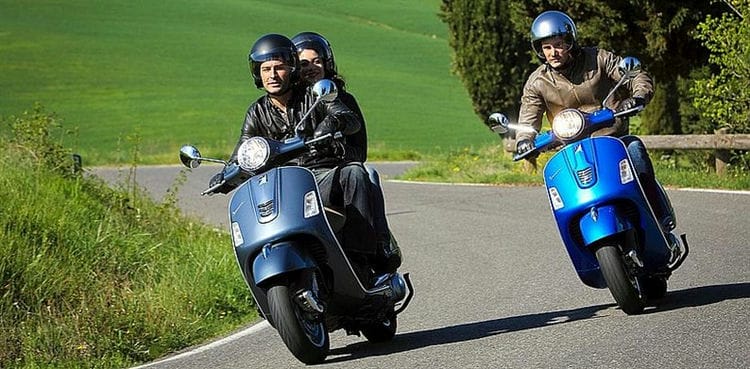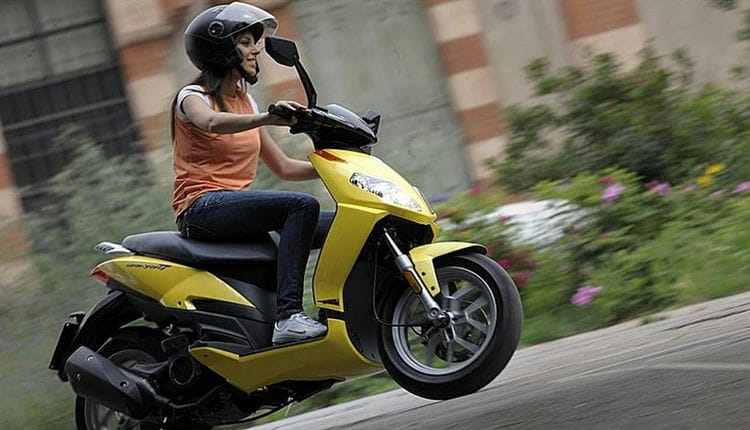Safety and preparation
-
Keep in mind the safety rules. Riding a motorcycle is associated with great health risks. Knowing and using simple rules can save your life and keep you healthy.
- Wear special motorcycle gear.
- Keep your distance from vehicles.
- Do not exceed the speed limit and keep to the traffic flow.
- Check periodically the condition of the motorcycle: tires, pedals, levers, headlights, battery, oil, chassis, footboards. T (Tires): tires and wheels; C (Controls) – controls: levers and pedals, cables, hoses, throttle; L (Lights) – light: battery, headlights, turn signals, mirrors and so on; O (Oil) – oil: liquid level and leaks; C (Chassis) – chassis: frame, suspension, chain and so on; S (Stands) – center and side steps.
-
Read the instructions for the motorcycle. Familiarize yourself with the controls and their locations. Standard controls:
- throttle handle on the right;
- brake lever on the right;
- clutch lever on the left;
- foot-pedal for gear shifting;
- speedometer and other sensors.
-
Know the rules of the road for motorcyclists. They differ from traffic rules for motorists. Check out the motorcycle specifics. For example:
- special insurance conditions for motorcyclists;
- rules for the carriage of passengers;
- speed limits;
- use of dedicated lanes;
- motorcycle noise restrictions.
-
Hand over to the right. Complete the training and pass the Category A license exam.
How a motorcycle works
-
Get an experienced mentor. Contact a driving school or ask a friend to help you with practice.
-
Get on the motorcycle. Correct fit is very important – if you fall with a motorcycle that weighs hundreds of kilograms, you can get injured. Follow these tips:
- Lean slightly towards the tank and put your hands on the steering wheel.
- Sit on the side of the footboard. If the footrest is in the center, it doesn’t matter which side you sit on. Never sit on the back of the motorcycle.
- Gently place your right leg over the motorcycle. Raise your leg as high as possible so as not to catch on something. Keep your weight on your support leg until you sit on the motorcycle. [1]
-
Tune in and customize the bike. Find a comfortable position, get used to the location of the controls, adjust the mirrors.
-
Examine the controls. Ask your mentor to show you how to: get under way, accelerate, brake, change gears, park.
-
Gas and brake. The right handlebar usually contains the throttle and front brake. The rear brake is usually located under the right foot.
- Move the right stick toward you to engage throttle (acceleration). Be careful with the throttle, the movement should be smooth. Otherwise, there is a great risk that the motorcycle will simply fly out from under you.
- Press the right traction lever to apply the front brake. The front brake is usually used as the main brake. Again, the pressure should be smooth. To avoid pushing the lever too hard, you can use just two fingers – this approach works for most motorcycles.
- The rear brake is mainly used to stabilize the motorcycle on the road. The exception is motorcycles, where the bulk of the weight is concentrated in the rear of the motorcycle (biker versions, cruise versions) – on them the rear brakes are often more effective than the front ones. [2]
-
Clutch. The traction lever on the left is responsible for the clutch. As with the right lever, the two-finger technique can be used here. However, on some bikes this approach does not work and you need to use your entire palm.
- The clutch is the link between the engine and the transmission. Press the clutch to disengage the gears; release it to connect them and enable the selected speed.
- By analogy with throttle and brake, pressing should be smooth. [3]
-
Switching speeds. The CPT foot is usually under the left foot.
- Most motorcycles use a “1 down, 5 up” pattern: 6 speed (optional), 5 speed, 4 speed, 3 speed, 2 speed, neutral speed, 1 speed.
- It takes practice to get used to the switch. When changing speeds, look at the green indicator “N”.
- Consider the order of gear shifting: first, disengage the clutch with your left hand; shift the gear with your left foot; release the clutch smoothly.
- Gradually turn the throttle to get a smoother gear change. [4]
- For more information on shifting gears, see the article “How to change gears on a motorcycle”.
-
Start the engine. Modern motorcycles do not need to kick start as they are equipped with a starter. In order to start the motorcycle, you need to follow simple steps:
- The switch should be in the “on” position (usually the switch is red and located on the right handle).
- Turn the key to the ignition position. The motorcycle will perform a self test. Make sure the motorcycle is in neutral (double check this by making sure the green “N” indicator is lit on the instrument panel).
- Release the clutch to start the motorcycle.
- Using your right thumb, press the ignition button, which is usually located below the switch and is marked with a circular arrow logo surrounding the lightning bolt. On some bikes, you need to depress the clutch to get the engine to work.
- Wait about a minute for the engine to warm up. This can take from 45 seconds to several minutes. Warming up the engine of a motorcycle, unlike cars, is an essential component of a safe ride. [5]
-
Remember to remove the footrest. With just one slight movement of your left foot, the footrest is tucked neatly under the bottom of the bike. You are now seated in the saddle, your feet are on the ground, and you are ready to ride.
So practice
-
Find an isolated place to practice. It would still be nice to have a mentor with you.
-
Drive smoothly and slowly. Use the first speed for reliability. Remember to place your feet on the props when the motorcycle has reached sufficient speed.
- Squeeze the clutch to disengage it.
- Shift into first gear with your foot.
- Release the clutch slowly.
- Turn the throttle knob to keep the engine from stalling.
- You will feel how the motorcycle started. As soon as you gain momentum, place your feet on the stands. Congratulations! You are driving a motorcycle! Check the brakes before entering the road.
-
Use counter-steering. This technique is as follows:
- Before turning at a speed of about 16 km / h, a short-term smooth turn of the steering wheel is made in the direction opposite to the turn. Then the steering wheel turns in the direction of the turn. Thus, the motorcycle falls to the side, as it were, and the desired tilt angle is achieved. When exiting a corner, counter-steering is applied in the opposite direction.
-
Practice shifting gears. With experience and confidence at low speeds, you can move up to higher speeds. Be extremely careful, smoothly press on the clutch, gas and brakes. The “grace” of movement will come with practice and time.
-
Start driving around the city, observing the rules and respecting other road users. [6]
Advice
- “Where you look – there you go.” Do not look at the ground under your feet – fall over. If there is an obstacle in front of you, do not look at it, but look where you need to go. You need to keep a lot in the review, but you don’t need to get stuck on one thing.
Warnings
- Remember that a motorcyclist is, by definition, less protected than a car driver. Appreciate your life and use protective equipment, or at least a helmet. Read as much information as possible about safe motorcycle riding.
- You need to learn from a professional (in a driving school), or from an experienced adult.
How to ride a motorcycle? How to drive a motorcycle?
Safety factor
Sitting behind the wheel of a motorcycle, you need to understand that you will not have any means of passive and active protection, like motorists. This means that the choice of specialized gear is critical. It is this that increases the survival rate of motorcyclists in the event of an accident. It is definitely impossible to save on equipment. The choice of workwear, helmet, gloves, boots should be approached carefully, paying attention to the quality and strength of materials. 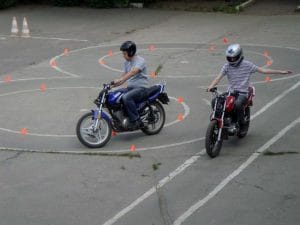 After purchasing the necessary equipment, you can start practicing. For this, beginners are best suited not to a road, but to an open area, for example, an empty parking lot or a sports ground without people.
After purchasing the necessary equipment, you can start practicing. For this, beginners are best suited not to a road, but to an open area, for example, an empty parking lot or a sports ground without people.
Comfortable fit
Newbie riders often have difficulty getting on the motorcycle. This largely depends on his height, the height of the person and the absence of a developed habit. For more comfort, at first it is recommended to sit on the left side. First you need:
- Stand on your left foot. To “catch” the balance, you can lean against the gas tank.
- Shift the center of gravity to the steering wheel.
- Raise your right leg and throw it over the seat.
You should not lift your foot high or push off strongly from the ground, as there is a risk of losing your balance and falling with the bike.
Getting used to the motorcycle
A motorcycle is a vehicle with a pretty cool temper, so you shouldn’t jump into the saddle right away. Better to start with basic exercises. To feel the weight of the bike and get used to its center of gravity, you need to walk alongside, driving it behind the wheel. At first glance, this is an elementary task, but everything is not so simple. Even removing and standing the motorcycle is not as easy as it sounds. So that it does not outweigh your own weight and does not fall, you need to tilt it slightly towards yourself. But the main thing here is not to overdo it, otherwise the bike will fall right on you.  Basic exercises for beginners:
Basic exercises for beginners:
- Complete the circle counterclockwise. You should start with this as the bike’s center of gravity will shift towards you, making it easier to catch and level.
- Complete the circle clockwise. This is a more difficult task. The vehicle will begin to pull in the opposite direction, and it will become much harder to hold it.
These basic actions help the muscles adjust to the bike’s weight and remember the effort needed to control it. Therefore, it is with them that lessons in a driving school begin. The skills brought to automatism in the future will allow you to feel comfortable at any height and weight of the motorcycle. You can sit behind the wheel when you have learned to confidently balance and steer the vehicle with the front brake and little effort.
Exercise “Scooter”
To practice the technique, you will need a flat platform with a slight slope. You do not need to start the engine. The challenge is to slide downhill while sitting on the bike. In this case, you should slightly tilt the body to the left and right and “catch” the center of gravity of the motorcycle. Thus, it will be possible to safely experiment with maneuvers and understand at what degree you can still level off, and at which level you cannot avoid falling. Also practice jumping onto the bike while walking from the left side. This skill is useful in case of problems with the battery and kick starter. This is a rather rare situation, but it certainly doesn’t hurt to be prepared for it. Such simple exercises allow you to get used to the physiometric data of a motorcycle, critical deflection angles and other nuances that will help you drive a vehicle in the future without being afraid of its weight and center of gravity.
How do I control the clutch on a motorcycle?
The clutch lever is similar to the front brake lever, except that it is located in front of the left handlebar of the motorcycle. Most sport bikes only require two fingers to operate this lever (pictured above), while touring, cruising, and other types of bikes often require an entire hand to grasp the lever (pictured below).
The clutch function on a motorcycle is different from how it works on a car. Think of the clutch as a way of connecting and disconnecting the engine from gears – as in neutral. When you press the clutch lever, you put the motorcycle into neutral (even if the shift lever is in gear). When you release the clutch, you let the engine turn the gearbox and rear wheel.
However, just like in a car, the grip on a motorcycle is not just “On / Off” modes – it is, first of all, a smooth release of the lever after it is squeezed. It takes a little practice to get used to it.
How to shift gears on a motorcycle?
Motorcycles also work a little differently in terms of gear shifting than cars. While the gearbox in them works on the same principle, the shifting itself is performed by moving the shift lever up or down with the left foot. The most common shift lever order (straight from top to bottom) is:
- 6th gear (if available),
- 5th gear
- 4th gear
- 3rd gear
- 2nd gear
- neutral gear
- 1st gear
The vast majority of motorcycles have this type of shift lever pattern, which is often referred to as “One in five” or “One down – Five up”. Finding neutral with your left foot will take a while to get used to, and as you push the shift lever forwards and backwards, you can look at the green “N” indicator on the dashboard. While most motorcycles can shift without using the clutch, it is still a good habit to use the clutch every time you shift.
The gear change itself should be carried out in the following order:
- Disengage the clutch (using your left hand, push the clutch lever all the way down).
- Shift the gear with your left foot.
- Release the clutch smoothly.
You see, like in a car – and here it is also important to switch in the desired engine speed ranges.
How to start a motorcycle?
Now that you are familiar with the basic functions of the motorcycle, it is time to start it. In contrast to the well-established image of a guy kicking a special lever, trying to start an old Jupiter or Minsk in this way, practically all modern motorcycles start with a starter without having to start the engine with a kick. The bike will not start if the switch is in the “off” position, so flip it down before turning on the key (the switch is usually a red toggle switch that is operated with your right thumb as shown in the top half of the photo). Now turn the key to the “ignition” position, which is usually achieved by turning it to the right (clockwise, as shown in the bottom half of the photo). Most bikes, like their older brothers – cars – will perform self-tests to make sure the sensors are in good working order. When the self-test is complete, check that the motorcycle is in neutral (double check this by making sure the green “N” indicator on the instrument panel is illuminated).
Then, using your right thumb, press the start button, which is usually located below the switch and is marked with the logo of a circular arrow that surrounds the lightning bolt. Many bikes will require you to depress the clutch when starting the engine – this is just a precaution to prevent the bike from suddenly blowing forward while in gear.
Warm up the motorcycle engine
Any internal combustion engine will achieve optimum performance when it gets warm enough, but the practice of warming up automobile engines is largely outdated. Riding a motorcycle, however, requires the rider to make sure that the engine will produce a predictable amount of power (a cold engine is unstable because gasoline flows unevenly in it) when needed, so warming up the motorcycle is still an important part of the riding ritual – especially when the motorcycle is carbureted, as opposed to a fuel injection bike. After the engine has started, let it idle for 45 seconds to several minutes.
Remove the footrest
Most modern motorcycles will automatically choke off if you try to engage a gear while the footrest is still down. If your bike is not equipped with this feature, make sure you remove the footrest – literally one slight movement of your left foot allows the footpeg to fit neatly under the bottom of the motorcycle.
Getting under way
After preliminary workouts, you can start starting the engine, shifting gears, working with the clutch, braking and performing maneuvers. After landing on a motorcycle and warming up the engine, it is worth examining the operation of the throttle handle: its angle of deviation from zero, the number of revolutions. Before moving off, you need to make sure that the fuel is supplied correctly – without a shortage or excess. Otherwise, the bike will stall or jerk sharply, freeing itself from the hands. It is most convenient to determine the number of revolutions by ear. This is a matter of habit, and after developing it, you can easily do without a tachometer. The further algorithm of actions is as follows:
- disengage the clutch by pressing the lever all the way;
- switch to first gear;
- release the clutch smoothly until the engine speed drops;
- squeeze the clutch and disengage the gear;
- put the motorcycle in neutral.
This technique should be repeated until the skill is worked out to the level of automatism. This will help a lot later on at traffic lights and during stops. After fixing this exercise, you can really get under way. Beginners should try brisk walking. To do this, you need to put your feet in front of you and release the lever until you go forward. In this position, using only the lever, ride back and forth on the platform, supporting the bike with your feet. The next step in learning to ride a motorcycle is riding in a straight line. Algorithm of actions:
- release the lever slowly;
- release throttle to reduce speed;
- put your feet on the pedals and drive the vehicle in a straight line;
- pull the lever and slowly apply the front and rear brakes immediately to stop;
- stretch the left leg to stop the movement;
- after a complete stop, put your right foot on the ground.
Riding a motorcycle – basic ingredients
Common sense
Traffic overview
Rear view mirrors. Blind spots.
Distribution of attention
Positioning on the road
Safe distance
Stopping way
Use of light and sound signals
Turn signals
Stop signal
Sound signal
Head light signals
Signs of courtesy
A few tips to help a newly minted motorcyclist
Explore the capabilities of your motorcycle
This is one of the most important questions. Almost every motorcycle, even beginner models, can easily leave most of the cars behind. The point is, 99 percent of motorcyclists starting their adventure want to explore these possibilities. Many times I saw boys standing at traffic lights in front of a sports car, forcing the driver to immediately prove that his car was the fastest. The driver must overtake the motorcyclist within three seconds after the traffic light turns green.
Today, after years of driving on two wheels, when I encounter such a person, I allow him to feel the taste of victory and joy that his fifteen-year-old BMW, with its plastic spoiler fluttering in the wind, is still a speed demon. But I know that it is not so easy to assume in the beginning. Without knowing your bike, its speed, acceleration, and limitations, any such ride can end in tragedy.
Motorcycle not for idiots
Each motorcycle model has its own Bible called a user manual. It is most often referred to when there is a problem or a question about replacing parts or consumable fluids. Here’s my advice. Read your motorcycle manual and it is best to do it several times. It is a veritable treasure trove of knowledge, including potential problems and solutions and how to resolve them.
Do you know how to turn headlights on and off on your motorcycle? Do you remember how tire pressure should be? Do you know what the icons on the watch or display mean, do you know the functions of all the switches? This is not a secret knowledge, and it is worth having all the information not only in the user manual, but, above all, in your head.
The throttle is very sensitive
You’ve probably seen a video on YouTube of a novice motorcyclist clinging to an unscrewed roll gas and crashing into some kind of fence, tree, or something else. Do you think this only happens with newbies? Well no. A small engine with a small flywheel responds much more to throttle control than a larger engine.
Lack of experience means that you, as a beginner, will often “fuel” too much. In some situations, you may even lose control of the motorcycle. Actually, throttle control takes practice, so don’t go crazy and know that it is a tricky art.
Discarded gears
For the same reasons, the operation of the gears is not very smooth at first, and the most common problem is dropping too early or too late. I’m not even talking about engine braking, but a smooth ride around town. Also remember that if you drop the clutch on the move and have the control knob unscrewed, the engine will not stall and the bike will jerk like crazy, ramming everything and everyone in its path.
The clutch function on sport bikes is very different. Therefore, if you have had experience with a motorcycle with different characteristics, be sure to take it into account and approach the clutch with extreme caution.
Correct gear for correct speed
This is often overlooked, but it is no coincidence that the manufacturer specifies the speed ranges for each gear in the manual. On the road, it is better to stick to what the manufacturer has provided for this model. This needs to be practiced because if you rely solely on instinct, you may overload the engine. You will be punished at the gas station by paying more for the fuel.
Counter turn yes, but not at low speeds
One of the most important skills is a technique that does not work at parking speed. You just don’t have the right momentum to turn. In practice, every driver experiences this phenomenon, but the difference is in how conscious it is. We rely solely on the steering wheel to steer, and at the beginning it is enough to know about it.
Learning to stop
In a car, you simply put on the brake and then stop. In a motorcycle, you have two wheels and two independent systems. In addition, when the stopping process is complete, you should extend your leg and place it on the ground to prevent the motorcycle from toppling over. In a Category A course, we learn to use the front and rear brakes as well as the clutch and throttle, but it takes time to master all four things smoothly. Dosing the braking force to the front and rear brakes and emergency stops is another issue.
Use the entire lane
The topic is very controversial. Should a motorcyclist traveling relatively slowly drive along the side of the road?
In my opinion, no. Politeness is a great feature, but in practice I have been overtaken many times by car drivers, and a wheel from a truck can not only damage the mirror, but also kill me.
Better to drive in the middle of the lane. Of course, this is not a situation where you are traveling on the expressway and the speed of your scooter is 45 km / h.
Scooter (moped) driving rules for beginners
Driving a scooter is the prerogative of the younger generation, who loves to move quickly and feel a certain freedom while driving. Riding a scooter looks pretty straightforward, but you shouldn’t take it too lightly – it leads to negative and sometimes sad consequences. Therefore, it is recommended to follow a set of rules that will help you learn how to ride a moped and perform all movements correctly.
There are many videos to help you learn how to ride a scooter. But still, knowledge of the theory will help you cope with difficult situations that never arise on the road. How to drive a scooter so as not to face the unpleasant consequences of driving such a simple, but sometimes dangerous vehicle?
First stage
The scooter that you decide to constantly use must undergo technical inspections in order to exclude unwanted consequences during the period of active use. In this case, it is not worth saving, since the health of the driver very often depends on the condition and quality of the vehicle.
To begin with, it is worth remembering that the maneuverability of the vehicle, controllability and predictability directly depend on the correct and high-quality technical condition of the moped. It is recommended to check the level of each fluid in the moped before starting the journey. Carefully monitor the amount of oil so as not to provoke the engine seizure process. Start the scooter on the center stop or stand – this way you will exclude incorrect and accidental movement when the engine is warming up.
Second phase
Knowing about braking will help preserve health while moving. How to drive a moped? Learn to deliberately and correctly brake at the moment when the situation on the road requires it. Braking does not seem like a difficult task, but still, even a small mistake can cause serious injury and danger to others.
To avoid unpleasant incidents, follow certain points:
- Start the braking process in advance when you have calculated the end point of your stop.
- Use not only the rear, but also the front brake.
- It is not necessary to perform sharp braking, as it creates a danger for other participants in active road traffic.
- Constantly monitor the technical condition of the entire braking system. Wet or defective pads can distort braking.
- Consider the weather conditions – the braking distance depends on them, as well as the overall efficiency of the braking system.
- Remember that on poor quality road surfaces, calculating the trajectory and the braking distance itself becomes much more difficult. Therefore, be careful when you see changes in the asphalt or other road surface in your immediate path of travel.
If you do not follow simple rules, the moped can easily hit curbs, collide with other vehicles or pedestrians. Sometimes there are dangerous drifts and even a fall of the driver. When your successful drive is over, it is recommended that you turn off the engine. Pay attention to the place for future parking. Professionals advise against leaving your scooter on slopes or on poor road surfaces.
Stage three
Lots of videos tell you how to drive a scooter. One of the most important points is the passage of turns of any complexity and maneuverability. There are many myths and misconceptions, but the professionals give clear advice to help you drive the scooter correctly and efficiently.
In advance, visually calculate the trajectory along which you will enter the turn. Adjust the speed to the level you want. If the speed is too high, the likelihood of reduced traction performance increases – start maneuvers in moderation. Compliance with these rules allows you to correctly drive the scooter at the time of the bend.
You should not be a hero on the roads in the city, where there is constant active traffic and there are many pedestrians. An experienced driver enters the turn only after completing the braking procedure. Videos with extremals will not help you here.
Turn entry methods:
- Tilt your body along with the tilt of the moped.
- Only the vehicle can be tilted at low speed.
1 method. For a long time it has been recognized as universal and more in demand. An experienced rider of both large and small motorbikes speaks of this method as extremely convenient and extremely safe.
Method 2. It will require experience and skill. Used for cornering where the radius is significantly reduced. It is not worth the risk if you are driving a moped only for the first months. It is strictly forbidden for beginners to use the second method.
Always remember that the braking process must be completely completed at the moment the scooter enters a corner. This is the only way to protect yourself and others from unpleasant accidents and injuries. Compliance with such a simple but very important set of rules will greatly simplify driving and make it safe.
Proper scooter management helps to avoid many accidents that have negative consequences. Try to carefully cross the tram track only at angles that are close to straight. When entering such paths at an acute angle, the likelihood of falling off or with the moped increases. Do not drive into the rain on the lane markings, as they become very slippery and can disrupt your trajectory.
The rules are quite simple, but if you know them clearly and orient yourself in the current situation on the road, you will be able to carry your scooter without any consequences and negative moments that can darken a pleasant and comfortable trip.
Sources used and useful links on the topic: https://ru.wikihow.com/%D0%B5%D0%B7%D0%B4%D0%B8%D1%82%D1%8C-%D0%BD%D0% B0-% D0% BC% D0% BE% D1% 82% D0% BE% D1% 86% D0% B8% D0% BA% D0% BB% D0% B5 https://howcarworks.ru/%D0%B2 % D0% BE% D0% BF% D1% 80% D0% BE% D1% 81 /% D0% BA% D0% B0% D0% BA-% D0% B5% D0% B7% D0% B4% D0% B8 % D1% 82% D1% 8C-% D0% BD% D0% B0-% D0% BC% D0% BE% D1% 82% D0% BE% D1% 86% D0% B8% D0% BA% D0% BB % D0% B5-% D0% BA% D0% B0% D0% BA-% D1% 83% D0% BF% D1% 80% D0% B0% D0% B2% D0% BB% D1% 8F% D1% 82 % D1% 8C-% D0% BC% D0% BE% D1% 82% D0% BE% D1% 86% D0% B8% D0% BA% D0% BB% D0% BE% D0% BC https: // chempionauto .ru / poleznoe / kak-nauchitsya-ezdit-na-mototsikle-s-nulya / https://moto-control.ru/ezdit-na-motocikle/ https://motonoob.ru/10-vazhnyh-sovetov-nachinayushhim -mototsiklistam / https://zextrem.com/motor/moto/kak-upravlyat-skuterom.html

